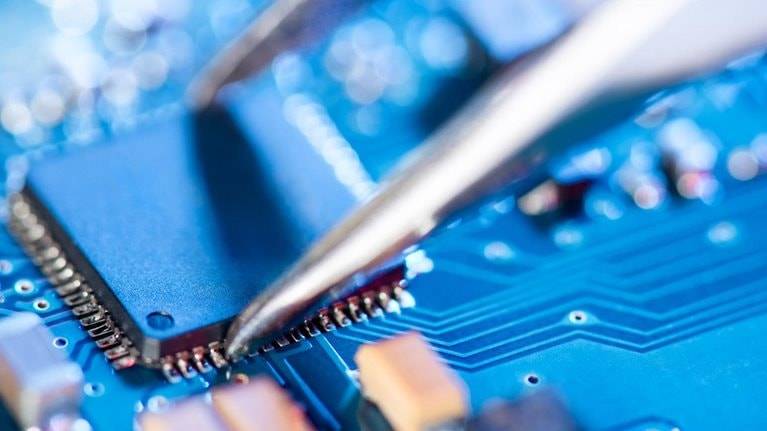Outside Silicon Valley, the semiconductor industry’s recent profitability seems unsurprising. The general assumption is that these players, like other tech companies, have long benefited from the rise of PCs, smartphones, and other devices. But insiders know that the industry’s good fortune is a relatively recent phenomenon. While software players were achieving record gains for most of the past two decades, most semiconductor companies achieved limited economic profitability. Overall, only microprocessor companies and some fabless players could count on consistently strong returns, above the cost of capital.
Now the semiconductor sector is showing strong and rising profits. What’s more, companies in virtually all subsegments are winning big. To discover how semiconductor companies engineered this turnaround, we analyzed trends related to economic profit (see sidebar, “Economic profit”).1 With this information, we wanted to answer an even more important question: What can semiconductor players do to ensure that the recent gains are not a blip but the emergence of a new industry norm?
A decade of change: How value creation has evolved within the semiconductor industry
Only ten years ago, the semiconductor industry had mediocre returns. Although many companies were generating value, they lagged far behind their counterparts in other industries. But a much different story has unfolded over the past five years, with the semiconductor industry reporting record gains. In 2017 alone, it generated $97 billion in economic profit—more than a threefold increase from the $28 billion captured in 2013 (Exhibit 1).

From 2012 to 2016, the semiconductor sector ranked tenth out of 59 major industries for value creation, placing it in the top 20 percent. That represents a big jump from the period from 2002 through 2006, when it ranked 18th. While the semiconductor sector still lags far behind software, which was second only to biotechnology, it now outranks IT services, aerospace and defense, chemical, and many other major sectors for value creation.
Would you like to learn more about our Semiconductors Practice?
Strong global economic growth since the 2008 recession has propelled the semiconductor industry’s revenues, but an even more important factor involves the continued rise of the technology sector. Companies such as Alibaba, Amazon, Facebook, Google, and Tencent become more important to the global economy every year. These companies constantly introduce product or technology upgrades to remain competitive, and they need chips to enable such advances. Semiconductor companies have also benefited from increased digitization and cloud use across other industries, both of which accelerate chip demand.

In addition to these traditional revenue drivers, some recent technology innovations, including the Internet of Things, artificial-intelligence (AI) applications, and blockchain technology, have created new opportunities for semiconductor companies to capture value. Advances in the automotive industry, including vehicle electrification and the development of self-driving cars, are also increasing chip demand. Such innovations are transforming how much value semiconductor companies capture from the technology stack. With AI applications, for instance, they could potentially achieve a larger share of total value than they did with PCs and mobile phones.
Value trends within the semiconductor industry
The rise in economic profit is not the only big shift within the semiconductor industry. As we reviewed the trends, we also found that value distribution has changed. From 1997 to 2012, the cumulative positive economic profit across segments was $161.5 billion. But some segments also lost value (Exhibit 2).
Overall, value was highly concentrated in a few areas (Exhibit 3). The microprocessor subsegment generated the most value, followed by fabless. Together, they created almost all value in the industry, with all other subsegments roughly breaking even when their results were totaled.

From 2013 to 2017, by contrast, nearly all subsegments recorded positive economic profit (Exhibit 4). Fabless was the best performer during this period, with memory in second place. The microprocessor subsegment came in third, down from the top ranking it held from 1997 to 2012. This shift occurred partly because PCs—key drivers of microprocessor demand—have seen much lower growth than smartphones and tablets, which often rely on chips designed by fabless players. Memory players have benefited from less oversupply, resulting in higher average sales prices and operating margins.

Several factors may contribute to the greater distribution of value, including industry consolidation. First, many large conglomerates have divested their semiconductor units over the past ten years to reduce R&D investment and capital expenditures. Meanwhile, the industry has also undergone a wave of M&A across segments. The number of semiconductor companies fell from 208 in 2012 to 173 by 2017 (Exhibit 5). The fabless subsegment saw the most consolidation, followed by analog integrated device manufacturers and diversified integrated device manufacturers, but the drop in companies is notable in all sectors, including memory.

Because there’s greater scale within subsegments, companies have more resources to invest in innovation and operating improvements. Their large size also helps them rebound when downturns occur in this highly cyclical industry, since they can take advantage of economies of scale and rely on more designs than in the past for their revenues. If one customer leaves, their bottom-line will not see the same hit as a smaller player with only a few accounts. Overall, down cycles have been milder and peaks have been higher within the semiconductor industry over the past few years (Exhibit 6).

Even when we factored goodwill—the amount of a purchase that exceeds the book value of the assets involved—into the calculation for the past five years, economic profit remained high. The fabless, memory, and microprocessor subsegments retained their top three ranking. Results for value creation were similar across most other subsegments, although some notable declines occurred. For instance, in the microprocessor subsegment, the positive cumulative economic profit for the period from 2013 to 2017 would be reduced from $39.7 billion to $28.3 billion if goodwill is included. Since all semiconductor subsegments have engaged in M&A to a similar extent, it is not surprising that the relative rankings remained similar.
Potential challenges: The rise of in-house chip design
After five successful years, semiconductor leaders across the industry have become a bit less optimistic about their prospects. Next to global tensions (hitting the semiconductor sector significantly, given the international value chains), one trend is generating new questions: the continued rise of in-house chip design at some of the semiconductor industry’s largest customers.
This shift may be most prominent at Apple. While the company still relies on external providers for PC chips, it uses in-house designers to make the core chips for the iPhone, AppleTV, iWatch, and some other offerings. Apple then outsources chip manufacture to foundries. The company gains several advantages by taking this path:
- Improved customer experience. Apple wants to optimize the customer experience and ensure that it is consistent across devices. While an external provider could create custom designs to meet these goals, an in-house team is more likely to satisfy the company’s exacting specifications and possess the necessary technical knowledge.
- Competitive differentiation. By developing proprietary technology, Apple prevents other companies from replicating its customer experience.
- Insight into road maps. In-house creation gives Apple firsthand insight into processing-technology capabilities, allowing it to create more accurate product road maps and enabling superior launch-planning for new products. For each offering, it can specify how and when it must update other technology elements to complement the processor.
- Negotiating leverage. The sheer volume of chips designed in-house provides a strong negotiating position with foundries.
While Apple has conducted in-house work for many years, the scale, extent, and impact of these operations might surprise even industry insiders (Exhibit 7). Apple is now the third largest fabless player in the world, behind Broadcom and Qualcomm Technologies. If the company were selling chips, its revenue would be around $15 billion to $20 billion annually, in line with Qualcomm Technology’s. And based on current multiples, Apple’s semiconductor business would be worth $40 billion to $80 billion.2 These numbers speak volumes about the strength of Apple’s internal chip operations.

Although shipments of iPhones and iPads appear to have peaked, Apple is still expected to expand its semiconductor footprint for iWatches and HomePods. It may also explore internal chip design for other products and components, such as those that enable power management and graphics.3 If Apple does go down this path, an important source of revenue may further shift away from stand-alone semiconductor companies.
Many technology companies with deep pockets have taken notice of Apple’s success with in-house chip design. Several, including large cloud players, are beginning to follow its example by developing AI chips.4 They have already had some significant wins, such as Google’s tensor processing unit and Amazon’s Graviton and Inferentia chips, all of which facilitate cloud computing.5 In-house creation allows these companies to develop customized chips that offer better performance and security. Costs are also potentially lower, since companies do not have to pay a designer’s premium. In the hotly competitive cloud market, these cost savings could help companies differentiate themselves from their rivals.
The development of ARM reference architectures, combined with the latest process improvements at state-of-the-art foundries, could now open the door to other tech companies that want to move design in-house—even those without deep pockets. If more companies begin designing chips in-house, the semiconductor industry will confront a new type of competitor—and that could have a long-term impact on demand and profitability.
Looking ahead: Investor expectations
Economic profit is strongly correlated with total returns to shareholders (TRS) across industries. Overall, the semiconductor industry’s TRS has declined about 10 percent since its peak in late 2018, partly because investors are worried that the weakening macroeconomic environment could affect semiconductor demand (Exhibit 8).

A look at earnings multiples might suggest that investors are even less optimistic about the industry’s long-term growth prospects. But it’s more likely that they recognize that 2018 profitability for semiconductors was significantly higher when it reached the top of the cycle than it had been in past years. Even as profits inevitably trend downward, investors still expect them to reach historic levels.

Winning through M&A? Deal making in the semiconductor sector
As for the subsegments, fabless now has the highest multiple, suggesting that investors think it will remain more profitable and might undergo additional M&A, which would increase its resilience (Exhibit 9). Memory, by contrast, has a low multiple, even though this subsegment has recently generated record profits. Investors may be concerned that this segment is more commoditized and therefore subject to sharper cyclic declines.

Fabless also has the highest enterprise value and is now the largest subsegment by far (Exhibit 10). Its ability to capture the highest economic profit, strong near-term growth prospects, and potential resiliency all contribute to higher investor expectations.

Potential strategies for semiconductor companies
Given the current landscape, semiconductor companies must accelerate value creation. Four actions seem essential:
- Creating strong road maps for leading customers. Semiconductor companies have long recognized the importance of delivering winning road maps for chip design, but the stakes are now higher than ever. In the past, customers that did not like a proposed road map might go to a competitor for their design needs. Such losses hurt, but they were often temporary because customers often came back to the original company for future designs. Now if customers are dissatisfied with a road map, they might move design capabilities in-house, resulting in a permanent loss of business.
- Using M&A in moderation. The semiconductor industry is still fragmented in many subsegments, and industry consolidation still makes sense. The best strategy involves programmatic M&A, in which companies acquire at least one company a year, spending an average of 2 to 5 percent of their market capitalization, with no single deal accounting for more than 30 percent of their market capitalization.6 These deals allow players to branch into adjacent areas to strengthen their competitive position. Deals that involve companies that only offer similar products will not produce as much value. One factor to consider when contemplating a deal is the value that it will bring to customers on measures such as price, quality, and performance. If an M&A deal could improve any of these areas, it will help the companies create a more compelling road map that positions them for future success. But companies that undertake M&A must avoid falling into the trap of paying too much for goodwill, or else they risk destroying value.
- Maintaining price discipline across the cycle. The large companies that have emerged from deal making have the resources required to create leading-edge chips. But they will only win if they focus on smart capacity planning and maintain relatively stable prices across economic cycles, even if demand slows.
- Preparing for vertical integration among tech giants. Many large tech players may try to acquire small niche companies, especially if they have desirable intellectual property, so they can increase their semiconductor capabilities. Other large players may choose to license their technologies, rather than buying chips, or to exit certain areas altogether instead of operating subscale.7
The semiconductor industry’s recent move to value creation is impressive, but companies cannot assume that the strong profits will continue indefinitely. The move to in-house chip design among their most important customers could hit their bottom lines hard. While the pace and extent of this shift are still unknown, the best companies will begin preparing now by revamping their strategies.



